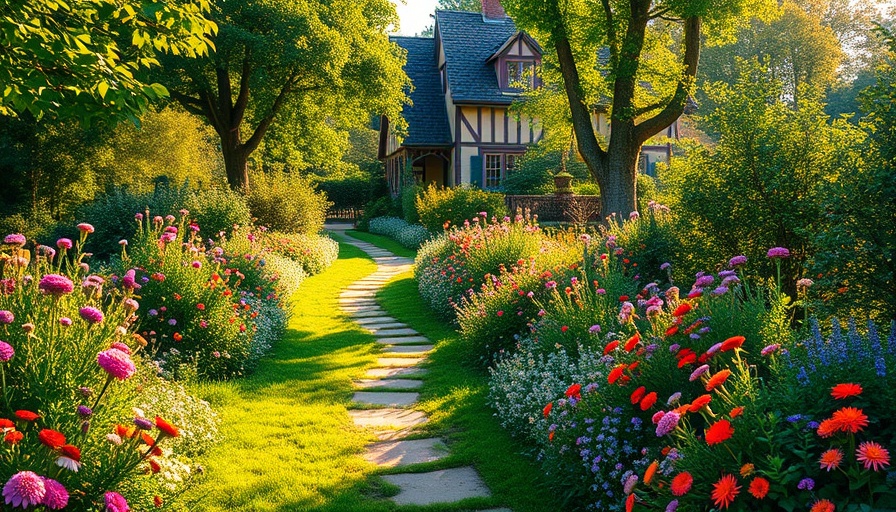
Unveiling the Allure of Jo Thompson’s Romantic Garden
In a world where the fast-paced hustle often drowns out the gentle rustle of leaves, garden designer Jo Thompson’s latest book, The New Romantic Garden, invites us to pause and embrace the beauty of our surroundings. With an impressive body of work spanning decades, Thompson captures an enchanting essence in her designs that melds nostalgia with modernity. This perfect amalgamation speaks to both seasoned gardeners and novices aspiring to create their own slice of paradise.
Thompson’s approach isn’t just about arranging flowers; it’s about cultivating stories. By deeply engaging with the history of the spaces she designs and the desires of her clients, she infuses life into gardens that feel both personal and timeless.
A Garden with a Narrative
The intricate relationship between a garden and its story is pivotal in Thompson’s philosophy. As she notes, establishing a narrative begins with understanding the space’s heritage. For example, in working with a Tudor-style home, she might incorporate elements such as medicinal plants reflective of that era without resorting to overreaching pastiche. Instead, her focus is on authenticity and respecting the natural lineage of each site.
Plant Life Takes Center Stage
Thompson's gardening mantra is clear: let the plants shine. In her designs, flora is emphasized over hard landscaping. A well-designed garden should maintain beauty even if stripped of its paths and stones. This ethos not only showcases the wonders of nature but also promotes sustainability, fitting seamlessly into the modern gardener's toolkit.
Embracing Local Materials
For Thompson, the choice of materials extends beyond aesthetics. By utilizing hyper-local resources—stones, timbers, and bricks sourced from the immediate environment—gardens become extensions of their locale. The use of native materials helps to establish a visual connection with the natural surroundings, fostering a more profound appreciation for the land.
The Timeless Rose
No romantic garden would be complete without roses, a motif prevalent in Thompson’s work. Despite common misconceptions about their resilience, the designer recommends selecting varieties tailored to specific conditions. For instance, the climbing rose 'The Generous Gardener' thrives in gardens that appreciate sun without compromising beauty. Importantly, Thompson advocates for planting roses in diverse settings, alongside companion plants like alliums and parsley, to combat diseases often associated with monoculture.
Cultivating the Perfect Veil
One of Thompson's striking techniques is creating a “veil” effect with taller plants that allows glimpses into the garden, enhancing intrigue and depth in the design. This unconventional arrangement deviates from traditional gardening norms, where height is typically reserved for the back. Instead, it fosters a mellow ambience likened to candlelight, softening the entire landscape.
Softening Hard Lines
To embody the romantic aesthetic fully, Thompson emphasizes the need to incorporate gentle transitions between different plant species. Rather than relying on rigid arrangements, her designs intertwine various flowers and foliage, echoing the informal beauty found in nature.
Creating a Personal Sanctuary
Romantic gardens serve as personal retreats. With paths that twist and turn and nooks that encourage quiet reflection, they invite homeowners to connect with nature on a more intimate level. As noted in the second reference, the use of soft lighting, comfortable seating, and sensorial elements like fragrant flowers intertwine to create a lush experience. Adding personal touches—like a hidden table for impromptu lunches—allows the garden to evolve into a vibrant social hub.
Conclusion: Cultivate Your Garden’s Story
Thompson’s The New Romantic Garden brings forward an invigorating outlook on garden design, encouraging us to draw inspiration from the past while forging connections with our environments. As spring approaches, there has never been a better time to bring romance back to your garden. Whether you are starting from scratch or enhancing an existing space, let the ideas articulated by Thompsons guide your journey.
Now is the moment to embrace this fresh aesthetic and create a garden that tells a story, reflects the beauty within, and becomes a living testament to the love and passion behind each bloom. Let Jo Thompson’s wisdom illuminate your path to a gorgeous garden.
 Add Row
Add Row  Add
Add 




Write A Comment